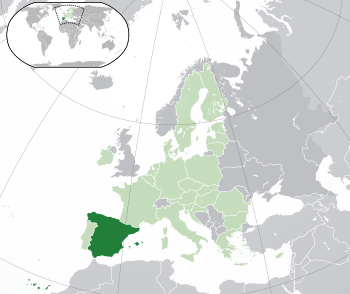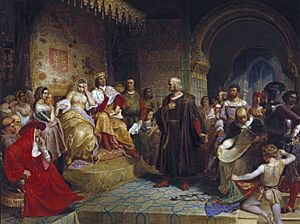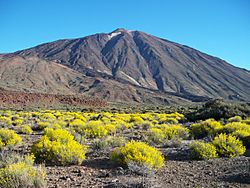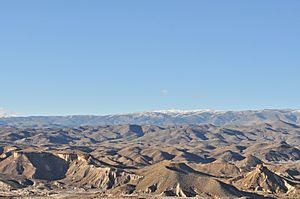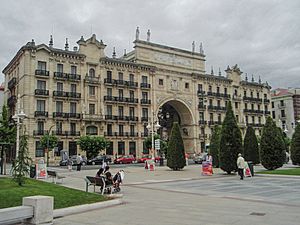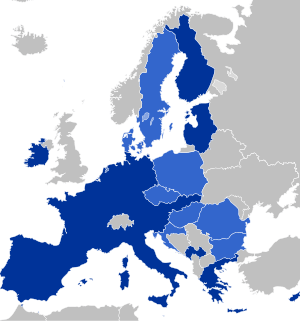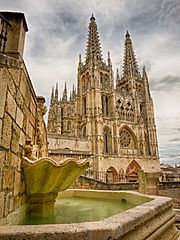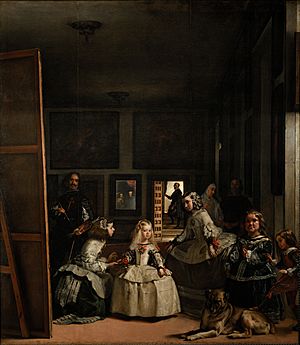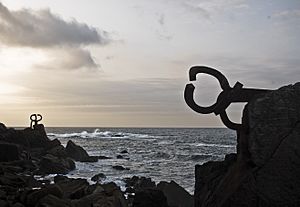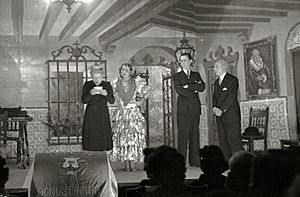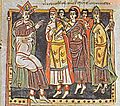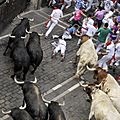Spain facts for kids
Quick facts for kids
Kingdom of Spain
|
|
|---|---|
|
Location of Spain (dark green)
– on the European continent (green & dark grey) |
|
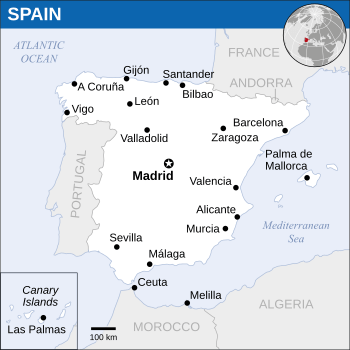 |
|
| Capital and largest city
|
Madrid 40°26′N 3°42′W / 40.433°N 3.700°W |
| Official language and national language |
Spanish |
| Ethnic groups
(2019)
|
|
| Religion
(2019)
|
|
| Demonym(s) |
|
| Government | Unitary parliamentary constitutional monarchy |
|
• Monarch
|
Felipe VI |
| Pedro Sánchez | |
| Pilar Llop | |
| Legislature | Cortes Generales |
| Senate | |
| Congress of Deputies | |
| Formation | |
|
• De facto
|
20 January 1479 |
|
• De jure
|
9 June 1715 |
| 19 March 1812 | |
| 29 December 1978 | |
|
• EEC accession
|
1 January 1986 |
| Area | |
|
• Total
|
505,990 km2 (195,360 sq mi) (51st) |
|
• Water (%)
|
1.04 |
| Population | |
|
• 2018 estimate
|
|
|
• Density
|
92/km2 (238.3/sq mi) (112th) |
| GDP (PPP) | 2020 estimate |
|
• Total
|
|
|
• Per capita
|
|
| GDP (nominal) | 2020 estimate |
|
• Total
|
|
|
• Per capita
|
|
| Gini (2018) | ▼ 33.2 medium · 103rd |
| HDI (2018) | very high · 25th |
| Currency | Euro (€) (EUR) |
| Time zone | UTC±0 to +1 (WET and CET) |
|
• Summer (DST)
|
UTC+1 to +2 (WEST and CEST) |
| Note: most of Spain observes CET/CEST, except the Canary Islands and Plazas de soberanía which observe WET/WEST.
|
|
| Date format | dd/mm/yyyy (CE) |
| Driving side | right |
| Calling code | +34 |
| ISO 3166 code | ES |
| Internet TLD | .es |
Spain is a country in Southern Europe. It is in the Iberian Peninsula near Portugal and Gibraltar. France and the country of Andorra are on its northeast side, where the Pyrenees mountains are.
The people of Spain are called Spaniards. Most people there speak Spanish (in Spanish, "Castellano", from Castilla, or "Español") but there are other languages in different parts of the country. They are Catalan, Basque, and Galician, Leonese, Aragonese, Aranese Occitan and even Portuguese. The religion of most of the people in Spain is Roman Catholic.
Since 1975, Spain has had a king who only does what the constitution allows him to. For example, the king can declare a war, but only if the Government asks him to do so. The parliament is called Las Cortes Generales, and has two bodies: "El Congreso" (The Congress) and "El Senado" (The Senate) and it is chosen by the Spanish people by voting. This kind of government is called a constitutional monarchy. The King of Spain is Felipe VI. The Prime minister is Pedro Sánchez.
The government and the king's palace are in Madrid, the capital of Spain.
Spain has more than five hundred thousand square kilometres of land. It is smaller than France, but it is bigger than Sweden or Germany. Almost fifty million people live in Spain.
Spain has 17 parts called autonomous communities (this means that they can decide upon some affairs themselves). Each part has its own government.
Contents
History of Spain
Early history
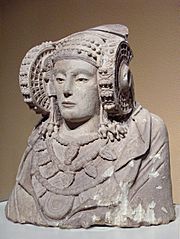
People have lived in Spain for a long time. There have been people living there since the Stone Age. Some of the first people to live there were Iberians and Celts, and the Phoenicians made a few cities there to get tin and silver to trade. Later, the Roman Empire controlled Spain for about five hundred years; then as the Roman Empire broke up, groups of Germanic people called Visigoths, Suebi, Alans and Vandals moved into the Iberian Peninsula and took it over.
Muslim occupation
In 711, the Umayyads took over, and later groups from North Africa, called the Moors, ruled most of Spain for eight hundred years, they called the land Al-Andalus. They were Muslims, and Muslim Spain was the farthest western point of Islamic civilization. This civilization was quite advanced at architecture and urban planning. The Moors were very wealthy because they controlled the gold trade from the Ghana Empire in West Africa. They built many beautiful buildings in all the land they controlled. Many of their large buildings still stand in cities in Andalusia, such as in Seville, Granada, and Cordoba.
Muslim Spain was multicultural and tolerant; Jews, Christians and Muslims lived side by side. There was also a large Slavic population (saqaliba) near the Mediterranean coast. Though these people were at first brought in to be slaves, some of them became generals (as did some Mamluks in another caliphate) and some generals became rulers of their own cities (taifas) for a short time. The Caliphate of Córdoba fell apart in the early 11th century and Muslim rulers sometimes fought each other when they weren't fighting the Christians. Muslim Spain was focused on learning. The greatest library system outside Baghdad was also there.
The Kingdom of León and the first European Parliament

The Kingdom of León, the most important in early Spanish Middle Ages, was born in 910. This Kingdom developed the first democratic parliament (Cortes de Llión) in Europe in 1188, where the third state was represented, and developed an economic system in 1202 where the monetary system was fixed. After 1301, León had the same King as the Kingdom of Castile, and kept as an independent territory until 1833, when Spain was divided into regions and provinces.
In 1492, they took the last part of Spain that still belonged to the Moors, Granada. Boabdil, the last Moorish King of Granada, surrendered to King Ferdinand II of Aragon and Isabella I of Castile on 2 January 1492. It was Ferdinand and Isabella of Castile who now ruled all of Spain.
Before this, there were a number of Christian countries in what is now called Spain. Two of these countries, Castile and Aragon, came together when Ferdinand II of Aragon married the queen Isabella of Castile. It is very important to know that the King ruled as much as the Queen.
In the same year, 1492, they sent Christopher Columbus to sail across the Atlantic Ocean. Columbus found the islands of the Caribbean Sea.
When other European sailors explored, like Hernán Cortés and Francisco Pizarro, they found out that there were two continents there - North America and South America. Spain sent many soldiers and businessmen to North and South America, and they took over very large parts of those two continents. This empire did not make Spain a rich country, for most of the money had to be spent in wars. Many of these wars were fought against other European countries who were trying to take over parts of the Americas.
Meanwhile, at home, the Muslim manuscripts had been either burnt or taken to other countries. Jews had also been expelled from Spain. Some Jews remained but they had to become Christians. Among the few things kept and respected in Spain were in music: harmony and stringed instruments. The buildings that had been built by the Moors were kept, and many Muslim religious buildings (mosques) were turned into churches. Some Jewish religious buildings were also turned into churches. Many Arab words became part of the Spanish Language.
16th and 17th century
The grandson of Ferdinand and Isabella, Charles, at the death of his grandfather inherited Castille and Aragon, he also inherited many territories at the death of his grandfather Maximilian I of Austria. Charles received from Maximilian the Austria state and the territories of Burgundy. He was named Charles I in Spain, but he was elected as the emperor of the Sacred German Empire, and was called Charles V in this territory. This made the empire bigger than ever. However, it was not a single country, but many independent countries with a single King. At first many Spaniards did not want Charles be their king, so they fought against him. However, he won.
Charles did not like the Protestant Reformation that was happening in Europe, and fought against it.
18th century
In the 18th century some of the parts of that large empire became their own countries, or were taken over by new countries, such as the United States of America.
19th century
Spain (and other European countries) was invaded by Napoleon of France. Spain, Britain and Europe sent its troops to defend the peninsula, since it was so weak.
20th century
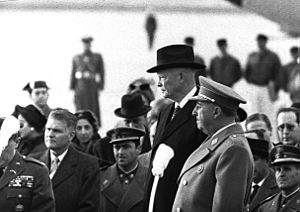
There was not much peace in Spain during the first part of the 20th century. Some Spaniards tried to set up a government chosen by the people (a democracy), and they made Alfonso XIII leave the country. However, in 1936, two different groups of Spaniards went to war over whether the government should be a democracy, in the Spanish Civil War (although those on the side of the Republic were largely socialist or anarchist), or take orders from one person. In 1939, those who wanted democracy were defeated, and a nationalist dictator named Francisco Franco took over the government.
Francisco Franco died on 20 November 1975. He had decided that Spain should have a monarchy again, and he chose Juan Carlos, the grandson of Juan of Bourbon who had been forced to leave the country, to be king and Adolfo Suárez to become its first Prime Minister. But the king and Suárez did not rule as a dictator; instead, they chose to set up a democracy.
On 23 February 1981 a group of people who had supported the now dead General Franco tried to take control of the democratic Spanish Parliament by force, they entered the building and fired guns in the air. It was seen live on Spanish television and there was widespread fear that this might be the start of another civil war. However, Juan Carlos I, quickly appeared on television and broadcast to the nation that they should remain calm. The persons responsible for the attempt to take over the country were arrested.
Now Spain is a modern democratic country, and does business with many countries around the world. It is the eighth largest economy in the world and is an important part of the European Union.
21st century
On 2 June 2014, Juan Carlos I announced that he would abdicate in favour of his son, Felipe VI. The date of abdication and handover to Felipe occurred on 19 June 2014. He and his wife kept their titles.
Religion
Ancient religions in Spain were mostly pagan. Today, however, at least 94 percent of Spain is Roman Catholic. Spanish mystic Teresa of Ávila is an important figure within Catholicism. The second largest Christian group is Orthodox. Other religions represented include Muslim, Baha'i Buddhists, Jain, Zoroastrianism and Unitarian Universalism. The country also has large atheist and agnostic communities.
Geography of Spain
The middle of Spain is a high, dry, flat land called La Meseta. In La Meseta it can be very hot in the summer and cold or very cold in the winter. Spain also has many mountain ranges. The Mount Teide (Tenerife, Canary Islands), the highest mountain of Spain and the islands of the Atlantic (it is the third largest volcano in the world from its base). In the north there is a range of mountains called Los Picos de Europa (The European Peaks). Here it is very cold in winter with a lot of snow but with gentle warm summers.
In the south-east of the country is a range of mountains called La Sierra Nevada (The Snowy Mountains). This range of mountains contains the highest mountain in mainland Spain, Mulacen, at 2952 metres. La Sierra Nevada is very popular in winter for winter sports, especially skiing. Snow remains on its peaks throughout the year. The south coast, has a warm and temperate climate, not very hot or very cold. Since Spain is in the south of Europe, it is very sunny. Many people from Northern Europe take their vacations in Spain, enjoying its beaches and cities.
Spain has a border with Portugal in the west and borders with France and Andorra in the North. In the south, it borders Gibraltar, a British territory. The Spanish territories of Ceuta and Melilla are in North Africa and border onto Morocco.
Regions
Spain is divided into Autonomous Communities, which means that they have their own regional governments. They are Andalucía (capital city Seville), Aragon (capital city Zaragoza), Asturias (capital city Oviedo), Balearic Islands (capital city Palma de Mallorca), Basque Country (capital city Vitoria), Canary Islands (capital cities Santa Cruz de Tenerife and Las Palmas), Cantabria (capital city Santander), Castilla-La Mancha (capital city Toledo), Castile and Leon (capital city Valladolid), Catalonia (capital city Barcelona), Extremadura (capital city Merida), Galicia (capital city Santiago de Compostela), La Rioja (capital city Logrono), Madrid Community (capital city Madrid), Murcia Community (capital city Murcia), Navarra (capital city Pamplona) and the Valencia Community (capital city Valencia).
City areas
In Spain, many people live in cities or close to cities. The ten biggest city areas are:
| Pos. | City area | Region | Prov. | population (city + area) |
|---|---|---|---|---|
| 1 | Madrid | Madrid | Madrid | 5,263,000 |
| 2 | Barcelona | Catalonia | Barcelona | 4,251,000 |
| 3 | Valencia | Valencian Community | Valencia | 1,499,000 |
| 4 | Sevilla | Andalucia | Seville | 1,262,000 |
| 5 | Bilbao | Basque Country | Biscay | 947,000 |
| 6 | Málaga | Andalusia | Málaga | 844,000 |
| 7 | Oviedo–Gijón | Asturias | Asturias | 844,000 |
| 8 | Alicante–Elche | Valencian Community | Alicante | 793,000 |
| 9 | Las Palmas de Gran Canaria | Canarias | Las Palmas de Gran Canaria | 640,000 |
| 10 | Zaragoza | Aragon | Zaragoza | 639,000 |
Climate
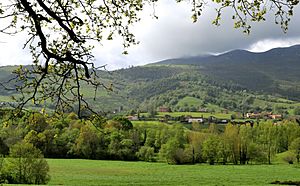
Three main climatic zones can be separated, according to geographical situation and orographic conditions:
- The Mediterranean climate, characterised by warm/hot and dry summers, is dominant in the peninsula. It has two varieties: Csa and Csb according to the Köppen climate classification.
- The Csa zone is associated to areas with hot summers. It is predominant in the Mediterranean and Southern Atlantic coast and inland throughout Andalusia, Extremadura and much, if not most, of the centre of the country. The Csa zone covers climatic zones with both relatively warm and cold winters which are considered extremely different to each other at a local level, reason for which Köppen classification is often eschewed within Spain. Local climatic maps generally divide the Mediterranean zone (which covers most of the country) between warm-winter and cold-winter zones, rather than according to summer temperatures.
- The Csb zone has warm rather than hot summers, and extends to additional cool-winter areas not typically associated with a Mediterranean climate, such as much of central and northern-central of Spain (e.g. western Castile–León, northeastern Castilla-La Mancha and northern Madrid) and into much rainier areas (notably Galicia). Note areas with relatively high rainfall such as Galicia are not considered Mediterranean under local classifications, but classed as oceanic.
- The semi-arid climate (BSk, BSh), is predominant in the southeastern quarter of the country, but is also widespread in other areas of Spain. It covers most of the Region of Murcia, southern Valencia and eastern Andalusia, where true hot desert climates also exist. Further to the north, it is predominant in the upper and mid reaches of the Ebro valley, which crosses southern Navarre, central Aragon and western Catalonia. It also is found in Madrid, Extremadura, Castilla-La Mancha, and some locations of western Andalusia. The dry season extends beyond the summer and average temperature depends on altitude and latitude.
- The oceanic climate (Cfb), located in the northern quarter of the country, especially in the Atlantic region (Basque Country, Cantabria, Asturias, and partly Galicia and Castile–León). Additionally it is also found in northern Navarre, in most highlands areas along the Iberian System and in the Pyrenean valleys, where a humid subtropical variant (Cfa) also occurs. Winter and summer temperatures are influenced by the ocean, and have no seasonal drought.
Fauna and flora
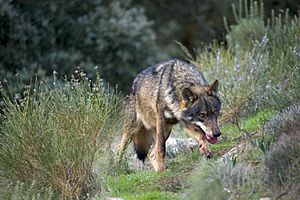
The fauna presents a wide diversity that is due in large part to the geographical position of the Iberian peninsula between the Atlantic and the Mediterranean and between Africa and Eurasia, and the great diversity of habitats and biotopes, the result of a considerable variety of climates and well differentiated regions.
The vegetation of Spain is varied due to several factors including the diversity of the relief, the climate and latitude. Spain includes different phytogeographic regions, each with its own floristic characteristics resulting largely from the interaction of climate, topography, soil type and fire, biotic factors.
Economy
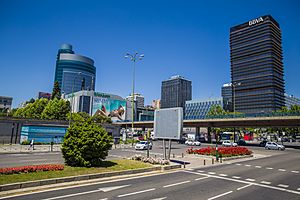
Since the 1990s some Spanish companies have gained multinational status, often expanding their activities in culturally close Latin America. Spain is the second biggest foreign investor there, after the United States. Spanish companies have also expanded into Asia, especially China and India. This early global expansion is a competitive advantage over its competitors and European neighbours. The reason for this early expansion is the booming interest towards Spanish language and culture in Asia and Africa and a corporate culture that learned to take risks in unstable markets.
Spanish companies invested in fields like renewable energy commercialisation (Iberdrola was the world's largest renewable energy operator), technology companies like Telefónica, Abengoa, Mondragon Corporation (which is the world's largest worker-owned cooperative), Movistar, Hisdesat, Indra, train manufacturers like CAF, Talgo, global corporations such as the textile company Inditex, petroleum companies like Repsol or Cepsa and infrastructure, with six of the ten biggest international construction firms specialising in transport being Spanish, like Ferrovial, Acciona, ACS, OHL and FCC.
Automotive industry
The automotive industry is one of the largest employers in the country. In 2015 Spain was the 8th largest automobile producer country in the world and the 2nd largest car manufacturer in Europe after Germany.
By 2016, the automotive industry was generating 8.7 percent of Spain's gross domestic product, employing about nine percent of the manufacturing industry. By 2008 the automobile industry was the 2nd most exported industry while in 2015 about 80% of the total production was for export.
German companies poured €4.8 billion into Spain in 2015, making the country the second-largest destination for German foreign direct investment behind only the U.S. The lion's share of that investment—€4 billion—went to the country's auto industry.
Agriculture
Crop areas were farmed in two highly diverse manners. Areas relying on non-irrigated cultivation (secano), which made up 85% of the entire crop area, depended solely on rainfall as a source of water. They included the humid regions of the north and the northwest, as well as vast arid zones that had not been irrigated. The much more productive regions devoted to irrigated cultivation (regadío) accounted for 3 million hectares in 1986, and the government hoped that this area would eventually double, as it already had doubled since 1950. Particularly noteworthy was the development in Almería—one of the most arid and desolate provinces of Spain—of winter crops of various fruits and vegetables for export to Europe.

More than half of the irrigated area was planted in corn, fruit trees, and vegetables. Other agricultural products that benefited from irrigation included grapes, cotton, sugar beets, potatoes, legumes, olive trees, mangos, strawberries, tomatoes, and fodder grasses. Depending on the nature of the crop, it was possible to harvest two successive crops in the same year on about 10% of the country's irrigated land.
Citrus fruits, vegetables, cereal grains, olive oil, and wine—Spain's traditional agricultural products—continued to be important in the 1980s. Ideal growing conditions, combined with proximity to important north European markets, made citrus fruits Spain's leading export. Fresh vegetables and fruits produced through intensive irrigation farming also became important export commodities, as did sunflower seed oil that was produced to compete with the more expensive olive oils in oversupply throughout the Mediterranean countries of the European Community.
Tourism
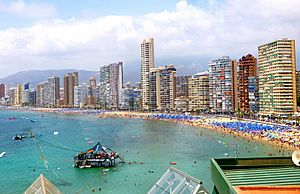
In 2017, Spain was the second most visited country in the world, recording 82 million tourists which marked the fifth consecutive year of record-beating numbers. The headquarters of the World Tourism Organization are located in Madrid.
Spain's geographic location, popular coastlines, diverse landscapes, historical legacy, vibrant culture, and excellent infrastructure has made the country's international tourist industry among the largest in the world. In the last five decades, international tourism in Spain has grown to become the second largest in the world in terms of spending, worth approximately 40 billion Euros or about 5% of GDP in 2006.
Castile and Leon is the Spanish leader in rural tourism linked to its environmental and architectural heritage.
Culture
Spain is a Western country. Almost every aspect of Spanish life is permeated by its Roman heritage, making Spain one of the major Latin countries of Europe. Spanish culture is marked by strong historic ties to Catholicism, which played a pivotal role in the country's formation and subsequent identity. Spanish art, architecture, cuisine, and music have been shaped by successive waves of foreign invaders, as well as by the country's Mediterranean climate and geography. The centuries-long colonial era globalised Spanish language and culture, with Spain also absorbing the cultural and commercial products of its diverse empire.
World Heritage Sites
Spain has 47 World Heritage Sites. These include the landscape of Monte Perdido in the Pyrenees, which is shared with France, the Prehistoric Rock Art Sites of the Côa Valley and Siega Verde, which is shared with Portugal, the Heritage of Mercury, shared with Slovenia and the Ancient and Primeval Beech Forests, shared with other countries of Europe. In addition, Spain has also 14 Intangible cultural heritage, or "Human treasures".
Art
Artists from Spain have been highly influential in the development of various European and American artistic movements. Due to historical, geographical and generational diversity, Spanish art has known a great number of influences. The Mediterranean heritage with Greco-Roman and some Moorish and influences in Spain, especially in Andalusia, is still evident today. European influences include Italy, Germany and France, especially during the Renaissance, Spanish Baroque and Neoclassical periods. There are many other autochthonous styles such as the Pre-Romanesque art and architecture, Herrerian architecture or the Isabelline Gothic.
During the Golden Age painters painters working in Spain included El Greco, José de Ribera, Bartolomé Esteban Murillo and Francisco Zurbarán. Also in the Baroque period Diego Velázquez created some of the most famous Spanish portraits, such as Las Meninas and Las Hilanderas.
Francisco Goya painted during a historical period that includes the Spanish Independence War, the fights between liberals and absolutists, and the rise of contemporary nations-states.
Joaquín Sorolla is a well-known modern impressionist painter and there are many important Spanish painters belonging to the modernism art movement, including Pablo Picasso, Salvador Dalí, Juan Gris and Joan Miró.
Sculpture
The Plateresque style extended from beginnings of the 16th century until the last third of the century and its stylistic influence pervaded the works of all great Spanish artists of the time. Alonso Berruguete (Valladolid School) is called the "Prince of Spanish sculpture". His main works were the upper stalls of the choir of the Cathedral of Toledo, the tomb of Cardinal Tavera in the same Cathedral, and the altarpiece of the Visitation in the church of Santa Úrsula in the same locality. Other notable sculptors were Bartolomé Ordóñez, Diego de Siloé, Juan de Juni and Damián Forment.
There were two Schools of special flair and talent: the Seville School, to which Juan Martínez Montañés belonged, whose most celebrated works are the Crucifix in the Cathedral of Seville, another in Vergara, and a Saint John; and the Granada School, to which Alonso Cano belonged, to whom an Immaculate Conception and a Virgin of Rosary, are attributed.
Other notable Andalusian Baroque sculptors were Pedro de Mena, Pedro Roldán and his daughter Luisa Roldán, Juan de Mesa and Pedro Duque Cornejo. In the 20th century the most important Spanish sculptors were Julio González, Pablo Gargallo, Eduardo Chillida, and Pablo Serrano.
Architecture
Due to its historical and geographical diversity, Spanish architecture has drawn from a host of influences. An important provincial city founded by the Romans and with an extensive Roman era infrastructure, Córdoba became the cultural capital, including fine Arabic style architecture, during the time of the Islamic Umayyad dynasty. Later Arab style architecture continued to be developed under successive Islamic dynasties, ending with the Nasrid, which built its famed palace complex in Granada.
Simultaneously, the Christian kingdoms gradually emerged and developed their own styles; developing a pre-Romanesque style when for a while isolated from contemporary mainstream European architectural influences during the earlier Middle Ages, they later integrated the Romanesque and Gothic streams. There was then an extraordinary flowering of the Gothic style that resulted in numerous instances being built throughout the entire territory. The Mudéjar style, from the 12th to 17th centuries, was developed by introducing Arab style motifs, patterns and elements into European architecture.
The arrival of Modernism in the academic arena produced much of the architecture of the 20th century. An influential style centred in Barcelona, known as modernisme, produced a number of important architects, of which Gaudí is one. The International style was led by groups like GATEPAC. Spain is currently experiencing a revolution in contemporary architecture and Spanish architects like Rafael Moneo, Santiago Calatrava, Ricardo Bofill as well as many others have gained worldwide renown.
Music and dance
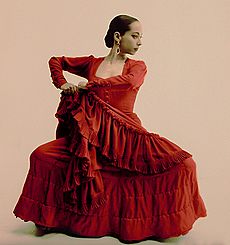
Spanish music is often considered abroad to be synonymous with flamenco, a West Andalusian musical genre, which, contrary to popular belief, is not widespread outside that region. Various regional styles of folk music abound in Aragon, Catalonia, Valencia, Castile, the Basque Country, Galicia, Cantabria and Asturias. Pop, rock, hip hop and heavy metal are also popular.
In the field of classical music, Spain has produced a number of noted composers such as Isaac Albéniz, Manuel de Falla and Enrique Granados and singers and performers such as Plácido Domingo, José Carreras, Montserrat Caballé, Alicia de Larrocha, Alfredo Kraus, Pablo Casals, Ricardo Viñes, José Iturbi, Pablo de Sarasate, Jordi Savall and Teresa Berganza. In Spain there are over forty professional orchestras, including the Orquestra Simfònica de Barcelona, Orquesta Nacional de España and the Orquesta Sinfónica de Madrid. Major opera houses include the Teatro Real, the Gran Teatre del Liceu, Teatro Arriaga and the El Palau de les Arts Reina Sofía.
Thousands of music fans also travel to Spain each year for internationally recognised summer music festivals Sónar which often features the top up and coming pop and techno acts, and Benicàssim which tends to feature alternative rock and dance acts. Both festivals mark Spain as an international music presence and reflect the tastes of young people in the country.
Vitoria-Gasteiz jazz festival is one of the main ones on its genre.
The most popular traditional musical instrument, the guitar, originated in Spain. Typical of the north are the traditional bag pipers or gaiteros, mainly in Asturias and Galicia.
Food
Languages
While Spanish is the most spoken language in the country, other languages like Catalan, Basque or Galician are also spoken in a few territories.
Other pages
Images for kids
-
The Lady of Elche, possibly depicting Tanit, from Carthaginian Iberia, 4th century BCE
-
The Roman Theatre in Mérida
-
Reccared I and bishops during Council III of Toledo, 589. Codex Vigilanus, fol. 145, Biblioteca del Escorial
-
Votive crown of Reccesuinth from the Treasure of Guarrazar
-
The interior of the Great Mosque of Córdoba
-
In 1030, the Kingdom of Navarre controlled the Count of Aragon and the Count of Castile, who later became major kingdoms of its time.
-
Lienzo de Tlaxcala codex showing the 1519 meeting of conquistador Hernán Cortés and his counsellor La Malinche with Aztec emperor Moctezuma II in Tenochtitlan.
-
The family of Philip V. During the Enlightenment in Spain a new royal family reigned, the House of Bourbon.
-
Demonstration in Barcelona during the 1909 Tragic Week events
-
Republican volunteers at Teruel, 1936
-
Felipe González signing the treaty of accession to the European Economic Community on 12 June 1985
-
The 1992 Summer Olympics in Barcelona
-
Satellite image of Mallorca island
-
Teide, still active volcano in Santa Cruz de Tenerife, Canary Islands is the greatest peak in Spain
-
Renault factory in Valladolid
-
Olive orchards in Andalusia.
-
Benidorm, one of Europe's largest coastal tourist destinations
-
Solar power plant Andasol was the first parabolic trough power plant in Europe. Because of the high altitude (1,100 m) and the semi-arid climate, the site has exceptionally high annual direct insolation of 2,200 kWh/m2 per year.
-
Population pyramid of Spain from 1950 to 2014
-
The interior of the Hermitage of El Rocío during a Catholic ceremony.
-
Manuscript of the 13th-century Grande e general estoria.
-
Pedro Almodóvar and Penélope Cruz in Oviedo
-
Flamenco is an Andalusian artistic form that evolved from Seguidilla.
-
Spain or La Roja lineup in 2015. Football is the most popular and profitable sport in the country.
-
Encierro, San Fermín, in Pamplona
See also
 In Spanish: España para niños
In Spanish: España para niños





